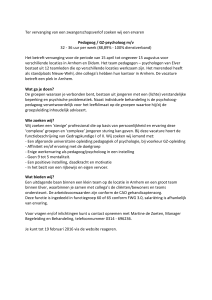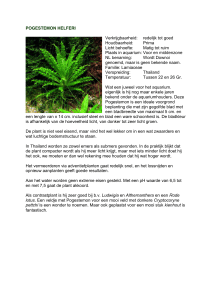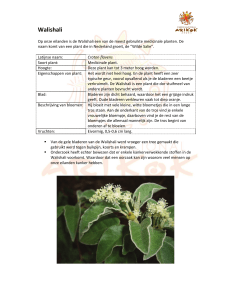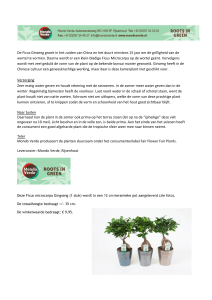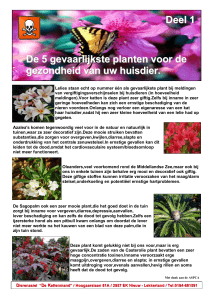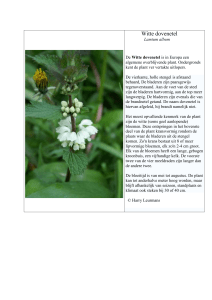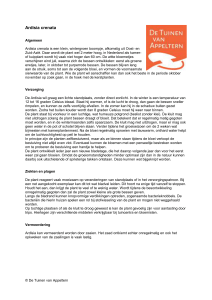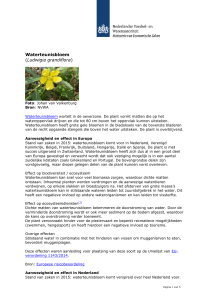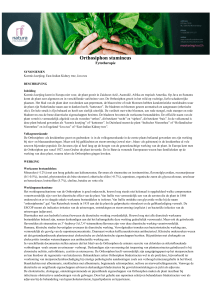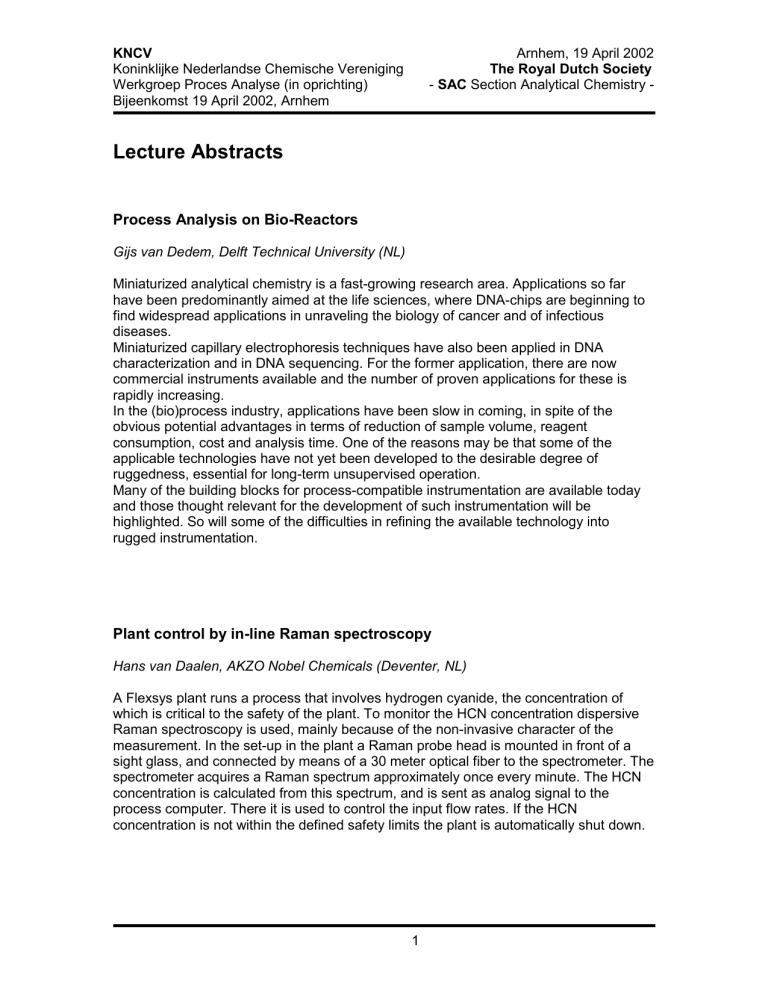
KNCV
Koninklijke Nederlandse Chemische Vereniging
Werkgroep Proces Analyse (in oprichting)
Bijeenkomst 19 April 2002, Arnhem
Arnhem, 19 April 2002
The Royal Dutch Society
- SAC Section Analytical Chemistry -
Lecture Abstracts
Process Analysis on Bio-Reactors
Gijs van Dedem, Delft Technical University (NL)
Miniaturized analytical chemistry is a fast-growing research area. Applications so far
have been predominantly aimed at the life sciences, where DNA-chips are beginning to
find widespread applications in unraveling the biology of cancer and of infectious
diseases.
Miniaturized capillary electrophoresis techniques have also been applied in DNA
characterization and in DNA sequencing. For the former application, there are now
commercial instruments available and the number of proven applications for these is
rapidly increasing.
In the (bio)process industry, applications have been slow in coming, in spite of the
obvious potential advantages in terms of reduction of sample volume, reagent
consumption, cost and analysis time. One of the reasons may be that some of the
applicable technologies have not yet been developed to the desirable degree of
ruggedness, essential for long-term unsupervised operation.
Many of the building blocks for process-compatible instrumentation are available today
and those thought relevant for the development of such instrumentation will be
highlighted. So will some of the difficulties in refining the available technology into
rugged instrumentation.
Plant control by in-line Raman spectroscopy
Hans van Daalen, AKZO Nobel Chemicals (Deventer, NL)
A Flexsys plant runs a process that involves hydrogen cyanide, the concentration of
which is critical to the safety of the plant. To monitor the HCN concentration dispersive
Raman spectroscopy is used, mainly because of the non-invasive character of the
measurement. In the set-up in the plant a Raman probe head is mounted in front of a
sight glass, and connected by means of a 30 meter optical fiber to the spectrometer. The
spectrometer acquires a Raman spectrum approximately once every minute. The HCN
concentration is calculated from this spectrum, and is sent as analog signal to the
process computer. There it is used to control the input flow rates. If the HCN
concentration is not within the defined safety limits the plant is automatically shut down.
1
KNCV
Koninklijke Nederlandse Chemische Vereniging
Werkgroep Proces Analyse (in oprichting)
Bijeenkomst 19 April 2002, Arnhem
Arnhem, 19 April 2002
The Royal Dutch Society
- SAC Section Analytical Chemistry -
Proces Analyse Applicaties bij Philips
Pieter de Bokx en Paul Krüsemann
Philips CFT (Materials Analysis), Prof. Holstlaan 4, 5656 AA Eindhoven (NL)
In 1999 is binnen de afdeling Materials Analysis van het Philips Centre for Industrial
Technology (CFT) een “dedicated” Proces Analyse activiteit opgezet. Wij specialiseren
ons in de toepassing van analytische chemie op het monitoren en beheersen van
industriële processen, zowel off-line (diagnostiek), at-line en on-line. Onze klanten zijn
zowel Philips bedrijven als geselecteerde derden. Ons dienstenaanbod bestaat uit:
Algemeen advies (confidentieel, vrij van “vendor bias”),
Ontwerpen en testen van instrumentatie voor procesbeheersing,
Snelle lab-schaal experimenten (“early problem solving”),
Calibratie & MSE (measurement system evaluation),
Data analyse & chemometrie.
Na een algemeen overzicht van onze activiteiten, zal op een tweetal onderwerpen nader
worden ingegaan:
Het gebruik van tunable-diode laser spectrometrie ten behoeve van “fast purging”
van compartimenten in optische systemen.
Snelle lab-schaal experimenten (thermische analyse) ten behoeve van optimalisatie
van procescondities van binder uitstook in de productie van plasma-displays.
Gebruik van multivariate data-analyse bij het onderzoek naar
kwaliteitsbepalende parameters van foto-chemicaliën
Harry Philipsen, Océ Technologies, Venlo:
Organische fotogeleiders (OPC) die gebruikt worden in copieerapparaten en printers
voor de beeldvorming van het te reproduceren origineel, zijn opgebouwd uit een aantal
lichtgevoelige lagen die diverse foto-chemicaliën bevatten. Bekend is dat de zuiverheid
van deze organische verbindingen van zeer grote invloed is op de uiteindelijke kwaliteit
van de OPC. Kleine verontreinigingen, in de orde grootte van 10 ppm kunnen de
werking ervan al drastisch beïnvloeden.
Het zoeken naar relaties tussen de samenstelling van de chemicaliën en de uiteindelijke
OPC kwaliteit is daarom moeizaam. Immers, op ppm nivo kunnen in vrijwel alle
organische verbindingen zeer veel verschillende producten worden aangetoond. Deze
grote hoeveelheid potentieel relevante variabelen maakte de inzet van multivariate dataanalyse tot een interessante optie.
Ten behoeve van de zuiverheidsanalyses van foto-chemicaliën werden daarom een
aantal methodes met hoge druk vloeistof chromatografie (HPLC) ontwikkeld, waarmee
een groot aantal verontreinigingen gescheiden en gekwantificeerd kunnen worden.
HPLC resultaten van een 20- tot 30-tal batches per product werden via de technieken
PCA en PLS gekoppeld aan foto-electrisch functioneren. Hiermee werd een indruk
verkregen over welke verontreinigingen schadelijk zijn en welke niet of minder. De
resultaten werden uiteindelijk bevestigd via een onafhankelijke, meer specifieke fysischchemische meetmethode.
2
KNCV
Koninklijke Nederlandse Chemische Vereniging
Werkgroep Proces Analyse (in oprichting)
Bijeenkomst 19 April 2002, Arnhem
Arnhem, 19 April 2002
The Royal Dutch Society
- SAC Section Analytical Chemistry -
Proces Analyse bij DSM – Aanpak en Applicaties
Michel Huys, DSM Research (Geleen , NL)
Een steeds nadrukkelijker uitdaging voor de expertise procesanalyse binnen DSM ligt in
het creëren van toegevoegde waarde van deze expertise voor de business. Hiertoe is
een methode ontwikkeld, een zogenaamde plant audit. De achterliggende gedachten
van de methode zullen toegelicht worden. Eén van de tools die gehanteerd wordt, maakt
gebruik van de meet- en regelbaarheidstheorie die door Prof. Van der Grinten (DSM-er)
is ontwikkeld eind jaren ‘50. Vervolgens zal aan de hand van een voorbeeld de
verschillende stappen in het ontwikkelingsproces van een applicatie geïllustreerd
worden. Als voorbeeld is gekozen voor een batch polymerisatie proces. De “cost of
ownership” om een applicatie operationeel te houden, wordt steeds nadrukkelijker
onderzocht.
New developments in pharmaceutical and chemical process monitoring
and control: the CPACT experience
Dave Rudd, GlaxoSmithClineWellcome (UK), Leslie Malcom (CPACT)
The Centre for Process Analytics and Control Technology (CPACT) is a major
partnership funded by UK industry and the Office of Science and Technology, via the
Engineering and Physical Sciences Research Council (EPSRC), involving three
Universities and 15 industrial companies. CPACT brings together inter-disciplinary
teams of researchers from industry and academia to address industry's needs in highly
responsive process manufacturing through industrially-driven and motivated research.
The present range of projects within CPACT is primarily concerned with the
development of improved process understanding and robustness, particularly for
pharmaceutical, chemical and fermentation operations. In this respect, industriallyfocussed research is currently being carried out into chemical reaction systems, process
modelling and optimisation, bioprocesses and solid materials processing. The
presentation will provide an overview of some of the activities which are on-going within
the CPACT collaboration, placing particular emphasis on the application of new or
existing measurement technologies to the development and control of robust
manufacturing processes. Such technologies include various forms of spectroscopy
(including near infra-red and light-induced fluoresecence), the use of ultrasonic
techniques and some applications of thermal monitoring. In addition, the complexity of
data interpretation will be discussed.
3

